The majority of the 65 numbered tombs in the Valley of the Kings can be considered minor tombs, either because at present they have yielded little information or because the results of their investigation was only poorly recorded by their explorers, while some have received very little attention or were only cursorily noted. Most of these tombs are small, often only consisting of a single burial chamber accessed by means of a shaft or a staircase with a corridor or a series of corridors leading to the chamber, but some are larger, multiple chambered tombs. These minor tombs served various purposes, some were intended for burials of lesser royalty or for private burials, some contained animal burials and others apparently never received a primary burial. In many cases these tombs also served secondary functions and later intrusive material has been found related to these secondary activities. While some of these tombs have been open since antiquity, the majority were discovered in the 19th and early 20th centuries during the height of exploration in the valley.
Tombs in the Valley of the Kings are assigned a numerical KV (for Kings' Valley) or WV (for West Valley) designation in the order of their discovery. Besides these numbered tombs there is also a series of pits and possible tomb commencements, ordered in an alphabetical sequence from WVA (actually a small tomb) to KVT although the exact number of these pits, and in many cases their location, is not known. The assignment of this alphabetical sequence has been done by more recent researchers, often on the basis of cursory references in older reports or field notes.
KV3 [1] is located in a side wadi of the main valley, adjacent to KV46 and KV4. Although it has been open since antiquity and had been visited by several explorers earlier on, the tomb was first excavated by Harry Burton in 1912. Before him both Edward R. Ayrton and James E. Quibell excavated in the vicinity of the tomb's entrance during 1904–1906. The work of these three men in and around the tomb was conducted for Theodore M. Davis.
The layout of KV3 resembles that of other Twentieth Dynasty tombs intended for members of the royal family in the Valley of the Queens. It consists of a corridor with two side chambers (one of which is unfinished) leading into a pillared chamber, again with partially finished side chambers, which in its turn gives access to three consecutive smaller rooms the first two of which have vaulted ceilings. The tomb has decoration in its corridor, depicting Ramesses III followed by a prince, while Carl Richard Lepsius, who visited the tomb in the mid-19th century, also mentions decoration elsewhere in the tomb which is now lost. It has been suggested that KV3 is the tomb mentioned on an ostracon dating from year 28 of Ramesses III, a tomb which was to be quarried in the valley for one of Ramesses's sons. The identity of the intended princely occupant of this tomb remains unknown but it has been suggested that this might have been the later Ramesses IV.
Burton's clearance of the tomb yielded no material of New Kingdom date and therefore it has been supposed that the tomb was never used for a burial. Later intrusive material from Byzantine times suggest the tomb was adapted as a Christian chapel by Copts.
KV12 [2] is located in the main valley and has been open since antiquity. It was cleared by Ernest Harold Jones in 1908–09 for Davis, while in 1920–21 Howard Carter unsuccessfully searched in the vicinity of the tombs entrance for foundation deposits.
The tomb has an unusual plan, with a staircase which leads directly into a room with one pillar from which a series of corridors lead down into multiple chambers. Markings for uncut doorways indicate that the tombs layout is unfinished. Differences in the quality of the quarrying and architectural style suggest the tomb was constructed over a period of time, starting in the Eighteenth Dynasty, continuing into the Nineteenth Dynasty, and possibly continuing afterwards. The tomb in its present layout was definitely in existence by the time of the construction of KV9 (tomb of Ramesses V and Ramesses VI) since the quarrying of that tomb collided with the rearmost chamber of KV12.
Other than shabtis belonging to Ramesses VI that were discovered at the entrance of the tomb, no datable material has been found and nothing is known of its intended occupant or occupants. However, it seems likely that the tomb was used during the Nineteenth Dynasty, and possibly the early Twentieth Dynasty, for multiple burials of lesser royalty (like KV5). These burials might have been disturbed by workmen quarrying KV9 and the tomb was likely further despoiled at the same time KV9 was broken into. The presence of Ramesses VI's shabtis near the entrance of KV12 might indicate that robbers gained access to both tombs via KV12.
KV13 [3] is located near KV14 (tomb of Twosret and Setnakhte). It has been partially open since antiquity but was only recently cleared by Hartwig Altenmüller. The tomb is unfinished and is formed by three sloping corridors, followed by two rooms and two further corridors leading to the burial chamber. The architecture of the tomb closely resembles that of KV14. A slight change in axis in the lower part of the tomb has been taken as evidence that the last corridor and burial chamber are later additions. The tomb has suffered severe flood damage and its ceilings have collapsed and most of the decoration is now lost.
Other than two anthropoid sarcophagi, found in the last corridor and the burial chamber, KV13 has yielded little remains. Its original quarrying has been attributed to Bay, a royal scribe under Seti II and later chancellor under Siptah, but it remains doubtful that he was ever buried here. The two sarcophagi are of a later, Twentieth Dynasty date. The tombs belong to Ramesses Mentuherkhepshef, a son of Ramesses IX, and Amenherkhepshef, probably a son of Ramesses III. The sarcophagus of the latter was usurped from its original owner Twosret.
KV19 [4] is located in one of the valley's side wadis, near KV20 and KV60. It was discovered by Giovanni Battista Belzoni in 1817. It was later excavated by James Burton (1825), Carter (1903) and Ayrton (1905–06), the later two working for Davis.
The tomb is unfinished and consists only of an open entryway, a first corridor and the beginning of a second corridor. A pit quarried just inside the second corridor might have functioned as a place of interment. The first corridor has decoration and texts indicating the occupant was a prince.
It seems likely that KV19 was originally intended for the burial of prince Ramesses Setherkhepeshef but its construction was abandoned when he ascended the throne as Ramesses VIII. The tomb was later taken over for the burial of prince Ramesses Mentuherkhepshef but his remains have not been found, neither in KV19 nor in either of the two royal caches. His sarcophagus was found in KV13 (see above). When the tomb was discovered, Belzoni found an unspecified number of intrusive burials, probably dating from the Twenty-second Dynasty.
KV26 [5] is located in the wadi that leads towards KV34 (tomb of Thutmose III), it was first noticed by James Burton in 1825. It is a small tomb, consisting of a short, level corridor and a single room accessed via a shaft. This tomb was never excavated and is partially covered in debris. Nothing is known regarding possible burial(s) or owner(s). Similarities in layout suggest it is of Eighteenth Dynasty date.
KV27 [6] is located in a side wadi, close to KV21 and KV28. It might have been known to both Belzoni and John Gardner Wilkinson but the only documented clearance is a partial excavation by Ryan in 1990. The tomb consists of a chamber, accessed by a shaft and with three side rooms. Although the remains of several mummies has been noted nothing is known about its possible owner(s). Ceramics datable to the reigns of Thutmose IV or Amenhotep III, the proximity of other tombs of the same period and architectural typology indicate a date in the Eighteenth Dynasty.
KV28 [7] is located only a few meters away from KV27. Like that tomb it was known to Wilkinson but has only been recently cleared by Ryan. The tomb consists of a single chamber accessed by a shaft, but the presence of an unexcavated doorway in the chambers back wall might lead to further rooms beyond. There is evidence for at least two burials in the tomb and besides human remains other finds include mummy trappings and pottery datable to the reign of Thutmose IV, which suggest an Eighteenth Dynasty date. Nothing is known of the tomb's intended owners.
KV29 [8] is located in the south-west wadi of the valley. It was first noted by James Burton. This tomb has never been excavated and remains inaccessible, it is possible that it consist only of a shaft. Nothing is known of its owner (if it was ever used), its content (if any), or the date of its construction.
KV30 [9] is located in the wadi leading towards KV34. It was discovered and excavated by Belzoni in 1817 for the Second Earl Belmore and the tomb is therefore also known as Lord Belmore's Tomb. It consists of a level corridor, accessed by a shaft and leading towards a chamber with four side rooms. The only finds recorded for this tomb is a potsherd datable to the Eighteenth Dynasty. Nothing further is known about it.
KV31 [10] lies between KV30 and KV32. It was discovered and excavated by Belzoni in 1817. Only its entry shaft is known today. Nothing further is known about this tomb.
KV32, [11] like KV30 and KV31, is located in the wadi that leads up towards KV34. It was discovered and excavated by Victor Loret in 1898, in 2000-01 it was re-excavated by the Swiss MISR Project. The tomb consists of an unfinished chamber with a central pillar and small side room that is reached by a series of stairwells and corridors. The latter quarried tomb KV47 (tomb of Siptah accidentally collided with the small side room of KV32.
The recent clearance of the tomb yielded a canopic chest belonging to queen Tiaa, the wife of Amenhotep II and mother of Thutmose IV, allowing the identification of KV32's owner and dating the tomb to the reign of Amenhotep II in the Eighteenth Dynasty.
KV33 [12] is located directly besides KV34. It was discovered and examined by Loret in 1898. It consist of a flight of steps leading to two rooms, although no accurate plan exists. Nothing further is known about this tomb and it is presently inaccessible, but it seems likely that it dates from the Eighteenth Dynasty. It has been suggested that it was a subsidiary tomb to KV34, although it appears that the tomb was never used.
KV37 [13] is located in the wadi leading towards KV34, KV32 is located nearby. It was first noted by James Burton and (re)discovered and examined by Loret in 1899. It consists of a single chamber reached by a stair and a corridor. Nothing is known about the primary burial. The tomb is dated to the Eighteenth Dynasty. A diverse range of objects was found in the tomb, dating from the Eighteenth and Nineteenth dynasties and it has been suggested that KV37 was used as a robbers "workshop".
KV40 [14] is located in the same wadi as the previous tombs. It was discovered and examined by Loret in 1899 but no report was published at that time. It contains the remains of minor 18th Dynasty royals and was reused for a 22nd Dynasty burial.
KV41 [15] is located outside the main valley in what is called the Valley of the Pits behind Deir el-Bahari. It was discovered and examined by Loret in 1899 and was re-examined in 1991 by the Institut Français d'Archéologie Orientale. The tomb consists of just a shaft of over 10 meters deep.
No objects were recovered from this tomb, and it seems likely that it was never finished or used. Nevertheless, it has been suggested this was a tomb intended for Tetisheri, wife of Senakhtenre Tao I of the Seventeenth Dynasty. If so, this would be one of the earliest tombs in the valley.
KV44 [16] is situated in a side wadi, close to KV45. It was discovered and excavated by Carter in 1901 and has recently been re-examined by Ryan. It consists of a single chamber accessed by a shaft. When discovered the tomb was blocked and inside were discovered three mummies in wooden coffins, these belonged to Tentkerer, a lady of the house of Osorkon I, Heiufaa, and an unnamed songstress of Amun. These burials, belonging to the Twenty-second Dynasty, are evidently secondary burials since they were placed on rubbish filling about one fifth of the tomb. In this rubble the remains of seven earlier mummies were found, without coffins or funerary equipment. Several bee nests on the ceiling indicate that the tomb had lain open for some time in antiquity. The original cutting of the tomb is dated to the Eighteenth Dynasty. Nothing is known of the original occupants of KV44 but it has been suggested that this was a tomb for Anen.
KV45 [17] is located next to KV44 and like that tomb it consists of a single chamber accessed by a shaft. It was discovered and excavated by Carter in 1902, it was recently cleared by Ryan. Like KV44 it had been used for (two) secondary burials during the Twenty-second Dynasty. Fragments of the original burial, including canopic jars (but no human remains) indicate the original owner was Userhet, overseer of the fields of Amun during the Eighteenth Dynasty.
KV48 [18] is located in the wadi leading to KV35 (tomb of Amenhotep II). It was discovered and excavated by Ayrton in 1906. It is formed by a single chamber accessed by a shaft. When discovered the tomb was blocked by a rebuild stone wall, indicating the tomb was entered and resealed in antiquity. However, it is unclear whether this rebuild wall was itself breached at a later point or not.
The contents of the tomb were evidently severely ransacked in antiquity. Ayrton found an unwrapped mummy on the floor, its coffin was only represented by fragments scattered about on the floor. Fragments of the usual funerary equipment (including a wooden chair, magical bricks and shabtis) were also recovered. Most of this material lay on top of a layer of rubble. This equipment identifies the owner of the tomb as Amenemopet called Pairy, a noble from the time of Amenhotep II (whose tomb is nearby). The fact that his burial was placed on top of a layer of debris indicates the tomb had been in existence and had been open for a while, there is nevertheless nothing to indicate that this was not the primary burial in this tomb. Amenemopet also had another tomb (TT29) in the Theban Necropolis.
KV48 is at present inaccessible.
KV49 [19] is located in the wadi leading to KV35, close to KV48. Like that tomb it was discovered and excavated by Ayrton in 1906. The tomb is unfinished and is formed by a staircase and a descending corridor leading towards a room with a further (unfinished) stairwell in its floor. The doorway leading to the tomb's single chamber shows traces of being blocked by a plastered stone wall in antiquity, which might indicate it was used for a burial at some point. The cutting of the tomb itself is dated to the Eighteenth Dynasty, but the tomb appears to have been accessible and used later during the New Kingdom as is evident from its contents (consisting of an ostracon, mummy wrappings, shreds of cloth and gaming pieces) and from two graffiti on its entrance doorway.
These text and the material found in the tomb have been interpreted in various ways. Some see in it evidence for the provisioning of a burial in KV49, others suggest the tomb was used as a storage for rags used as candles while others still suggest this tomb was used to restore the royal mummies during the time when the valley was dismantled and its occupants reburied in the royal caches.
These three tombs [20] [21] [22] are all located in the same general area as KV48 and KV49. They were discovered and excavated by Ayrton in 1906. All three are tombs with a single chamber accessed by a shaft and all three contained animal burials. These tombs had been robbed in antiquity, as is evident from the unwrapped state of the animals. The doorway to KV51 showed evidence of an original plaster and sealed blocking, but had been reblocked with loose stones and part of a coffin lid. Whereas KV51 was completely filled with animals, the other two tombs only contained a few mummies (two in KV50, one in KV52) and it is uncertain whether these two tombs had been intended to contain a human burial or not: KV50 contained fragmentary remains of a wooden coffin and KV52 an empty canopic chest.
KV51 contained material which was dated to the Eighteenth Dynasty, a dating which is ascribed to all three of these closely related tombs. It has also been suggested (although there is no real evidence to support this theory) that the animals interred here were a king's pets and that, given the proximity of his tomb (KV35), this king might have been Amenhotep II.
KV53 [23] is located north of KV29. It was discovered by Ayrton in 1905 or 1906. Although it was never properly planned it is reported to consist of a single chamber accessed by a shaft, rough workmen's huts were erected above its entrance. The only find from the chamber is an ostracon. Other ostraca and stelae/trail-pieces were found in the shaft. These items are contemporaneous with the huts build over the tomb. Given the lack of evidence it is unclear whether this tomb had ever contained a burial.
KV59 [24] is located in the wadi leading to KV34. It was first noted by James Burton in 1825 but there is no reference to its clearance and nothing is known about its possible contents. It is dated, on the grounds of its location, to the reign of Thutmose III.
KV61 [25] is located in the south-west wadi of the valley. It was discovered and excavated by Jones in 1910. It consists of a single chamber accessed by a shaft. When discovered, the doorway to the chamber was blocked but the tomb, which was partially filled with debris, yielded no finds. It has been suggested that the tomb once contained a burial, but that it was transferred elsewhere in its entirety, an idea which is perhaps unlikely. Another suggested theory is that the tomb was quarried and blocked up in anticipation of a burial which never took place. Given the lack of finds this tomb is undatable.
WV24 [26] is located near the end of the West Valley, in between WV23 and WV25. This tomb was first noted by Wilkinson but was only recently cleared by Otto Schaden in 1991–92. It is a single chamber tomb accessed by a shaft. The left and rear wall of the chamber are irregular in shape which might suggest the tomb was left unfinished. The room was filled with debris, partially consisting of chippings from its cutting and partially flood deposits. Material found in the tomb dates from the Eighteenth Dynasty into late Roman and Coptic periods, which suggests the tomb was reused several times. Remains of intrusive burials from at least five individuals dating from the Twenty-second Dynasty were also recovered.
WVA [27] is located near WV22 (tomb of Amenhotep III). It was first noted by Robert Hay and has been explored several times. It is a single chambered tomb accessed by a roughly hewn stair. Much of the tomb's original blocking is preserved. The room was partially filled with chips and debris in which were found the remains of numerous pottery fragments, along with jar sealings bearing the name of Amenhotep III. Other finds in the tomb are associated with tomb decoration. Other items reported from this tomb, such as fragments of a leather harness, possibly come from rubbish heaps outside the actual tomb. The blocking of its entrance and some of the items recovered from the tomb suggest it was at first used as a storage room related to WV22, other items could have originated from robbers' spoil left outside WV22. There is no evidence that this tomb ever received a burial.
(see above)
The following tombs might be noted here because they have similar layouts or served similar functions to the tombs listed above. These tombs however, unlike the preceding ones, yielded important information or have other notable features
Most of the tombs listed above that contained datable material are from the Eighteenth Dynasty. Other tombs have also been dated to this period, either because of similarities in architecture or because of their location, several of these tombs were reused in later times. Differences in architectural style suggest that KV5 and KV12 were originally quarried in the Eighteenth Dynasty but that they were reused and expanded during the Nineteenth Dynasty. Other than those two tombs the only tomb whose quarrying can be dated to the Nineteenth Dynasty is KV13. As noted above it is possible that the last corridor and burial chamber of this tomb were of a later date than the rest of the tomb, which might be related to its reuse in the Twentieth Dynasty. KV3 and KV19 can be dated to that dynasty as well, based on their architecture, decoration and their intended occupants.
As was noted above, if the suggested ownership of KV41 has any grounds this would be one of the earliest tombs excavated in the area and it would pre-date the establishment of the royal necropolis in the valley.

Tomb KV17, located in Egypt's Valley of the Kings and also known by the names "Belzoni's tomb", "the Tomb of Apis", and "the Tomb of Psammis, son of Nechois", is the tomb of Pharaoh Seti I of the Nineteenth Dynasty. It is one of the most decorated tombs in the valley, and is one of the largest and deepest tombs in the Valley of the Kings. It was uncovered by Italian archaeologist and explorer Giovanni Battista Belzoni on 16 October, 1817.

Tomb KV35 is the tomb of Pharaoh Amenhotep II located in the Valley of the Kings in Luxor, Egypt. Later, it was used as a cache for other royal mummies. It was discovered by Victor Loret in March 1898.

KV20 is a tomb in the Valley of the Kings (Egypt). It was probably the first royal tomb to be constructed in the valley. KV20 was the original burial place of Thutmose I and later was adapted by his daughter Hatshepsut to accommodate her and her father. The tomb was known to the Napoleonic expedition in 1799 and had been visited by several explorers between 1799 and 1903. A full clearance of the tomb was undertaken by Howard Carter in 1903–1904. KV20 is distinguishable from other tombs in the valley, both in its general layout and because of the atypical clockwise curvature of its corridors.
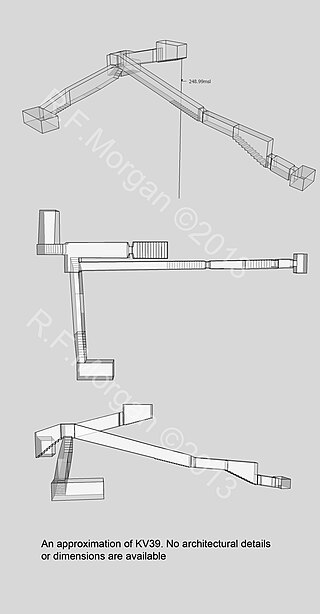
Tomb KV39 in Egypt's Valley of the Kings is one of the possible locations of the tomb of Pharaoh Amenhotep I. It is located high in the cliffs, away from the main valley bottom and other royal burials. It is in a small wadi that runs from the east side of Al-Qurn, directly under the ridge where the workmen's village of Deir el-Medina lies. The layout of the tomb is unique. It has two axes, one east and one south. Its construction seems to have occurred in three phases. It began as a simple straight axis tomb that never continued past the first room. In the subsequent phase, a series of long descending corridors and steps were cut to the east and south. It was discovered around 1900 by either Victor Loret or Macarious and Andraos but was not fully examined. It was excavated between 1989 and 1994 by John Rose and was further examined in 2002 by Ian Buckley. Based on the tomb's architecture and pottery found, it was likely cut in the early Eighteenth Dynasty, possibly for a queen. Fragmentary remains of burials were recovered from parts of the tomb but who they belong to is unknown. KV39's location may fit the description of the tomb of Amenhotep I given in the Abbott Papyrus but this is the subject of debate.
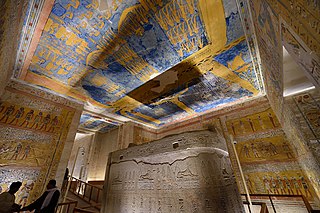
Tomb KV2, found in the Valley of the Kings, is the tomb of Ramesses IV, and is located low in the main valley, between KV7 and KV1. It has been open since antiquity and contains a large amount of graffiti.
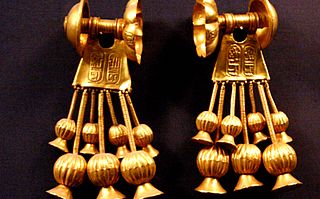
Tomb KV56, also known as the Gold Tomb, is a tomb located in the Valley of the Kings, near Luxor, Egypt. It was discovered by Edward R. Ayrton in January 1908 and contained what is thought to be the intact burial of a royal child from the late Nineteenth Dynasty. The burial and casket have disintegrated, leaving a thin layer of gold leaf and stucco in the original location. Most famously the tomb contained spectacular gold and silver jewellery including earrings, rings, silver bracelets with the names of Seti II and Twosret inscribed, and a pair of small silver gloves. The original occupant of this tomb is unknown but was possibly an Eighteenth Dynasty queen.

Tomb KV48 is an ancient Egyptian tomb located in the Valley of the Kings in Egypt. It was discovered in 1906 by Edward R. Ayrton excavating on behalf of Theodore M. Davis, and contained the robbed burial of the Eighteenth Dynasty noble Amenemipet called Pairy. It was re-excavated in 2009 by a team from the Pacific Lutheran University.
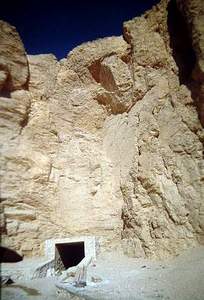
Tomb KV1, located in the Valley of the Kings in Egypt, was used for the burial of Pharaoh Ramesses VII of the Twentieth Dynasty. Although it has been open since antiquity, it was only properly investigated and cleared by Edwin Brock in 1984 and 1985. The single corridor tomb is located in Luxor's West Bank, and is small in comparison to other tombs of the Twentieth Dynasty.

Tomb KV3, located in Egypt's Valley of the Kings, was intended for the burial of an unidentified son of Pharaoh Ramesses III during the early part of the Twentieth Dynasty. It is similar in design to the "straight axis" tombs typical of this dynasty, and an ostracon written in hieratic script from the time of Ramesses III mentions the founding of a tomb for a royal prince, likely this tomb. The unfinished state of a couple of rooms in the tomb along with scant archeological evidence suggests that the tomb was never used. Some have suggested that it was originally intended for use by the prince regent who would succeed as Ramesses IV, and who started building his own tomb (KV2) soon after he came to the throne.

KV4 is a tomb in the Valley of the Kings (Egypt). The tomb was initiated for the burial of Ramesses XI but it is likely that its construction was abandoned and it was not used for Ramesses's interment. It also seems likely that Pinedjem I intended to usurp this tomb for his own burial, but that he too abandoned the plan. KV4 is notable for being the last royal tomb that was quarried in the Valley and because it has been interpreted as being a workshop used during the official dismantling of the royal necropolis in the early Third Intermediate Period.

Tomb KV26 is an ancient Egyptian tomb of the Eighteenth Dynasty located in Egypt's Valley of the Kings. It is located in a side valley leading to the tomb of Thutmose III (KV34). It was visited by the early Egyptologist James Burton in the 1820s or 1830s, and by Victor Loret in 1898. It was mapped in the 1980s by the Theban Mapping Project. The first documented excavation of the tomb was carried out in 2009 by the University of Basel's Kings' Valley Project. The tomb contained evidence of at least one burial and fragmented pottery and stone vessels of mid-Eighteenth Dynasty date but nothing is known about its occupant(s).
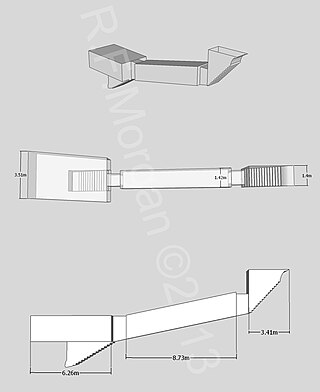
Tomb KV49, located in the Valley of the Kings, in Egypt is a typical Eighteenth Dynasty corridor tomb. It was the first of a series of tombs discovered in 1906 by Edward R. Ayrton in the course of his excavations on behalf of Theodore M. Davis. The tomb was abandoned before it was completed, and the work was halted as the stairwell in the single chamber was being cut. It was probably used as a store for royal linen, or was used as a mummy-restoration area in the later New Kingdom.
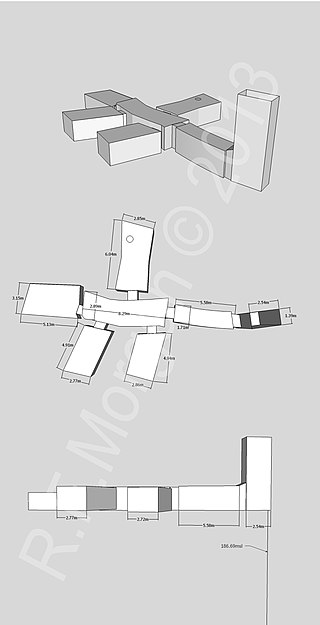
Tomb KV30 is an ancient Egyptian tomb located in the Valley of the Kings in Egypt. It likely dates to the mid-Eighteenth Dynasty and was used for the burial of an unknown individual. It may have been discovered by Giovanni Belzoni in 1817, working on a commission from the Second Earl Belmore. It was excavated in 2009-2010 by the University of Basel's Kings' Valley Project.

KV44 is an ancient Egyptian tomb located in the Valley of the Kings, Egypt. It was discovered and excavated by Howard Carter in 1901 and was re-examined in 1991 by Donald P. Ryan. The single chamber accessed by a shaft contained three intact Twenty-second Dynasty burials; the remains of seven mummies from the original interment were found within the fill. The original cutting of the tomb is dated to the Eighteenth Dynasty.

Tomb KV50 is located in the Valley of the Kings, in Egypt. It was discovered in 1906 by Edward R. Ayrton excavating on behalf of Theodore M. Davis. Together with KV51 and KV52, it forms a group known as the "Animal Tombs". It contained the burial of a dog mummy and a mummified monkey and is probably associated with the nearby tomb of Amenhotep II (KV35).
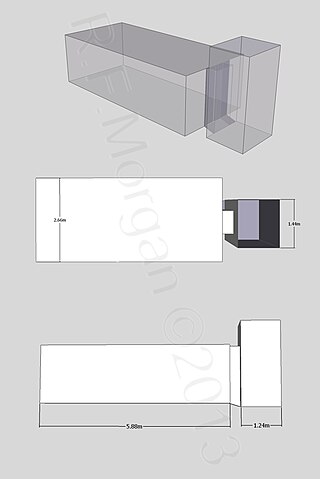
Tomb KV51 is located in the Valley of the Kings, in Egypt. It was discovered in 1906 by Edward R. Ayrton excavating on behalf of Theodore M. Davis. The tomb, together with KV50 and KV52 forms a group of three known as the "Animal Tombs". It contained the burials of three monkeys, one baboon, one ibis and three ducks, and is probably associated with the nearby tomb of Amenhotep II (KV35).

Tomb KV52 is located in the Valley of the Kings, in Egypt. It was discovered in 1906 by Edward R. Ayrton excavating on behalf of Theodore M. Davis. Together with KV50 and KV51 it forms a group known as the "Animal Tombs", it contained a mummified monkey, and is probably associated with the nearby tomb of Amenhotep II (KV35).

The Valley of the Kings, also known as the Valley of the Gates of the Kings, is a valley in Egypt where, for a period of nearly 500 years from the 16th to 11th century BC, rock-cut tombs were excavated for the pharaohs and powerful nobles of the New Kingdom.

KV64 is the tomb of an unknown Eighteenth Dynasty individual in the Valley of the Kings, near Luxor, Egypt that was re-used in the Twenty-second Dynasty for the burial of the priestess Nehmes Bastet, who held the office of "chantress" at the temple of Karnak. The tomb is located on the pathway to KV34 in the main Valley of the Kings. KV64 was discovered in 2011 and excavated in 2012 by Susanne Bickel and Elina Paulin-Grothe of the University of Basel.